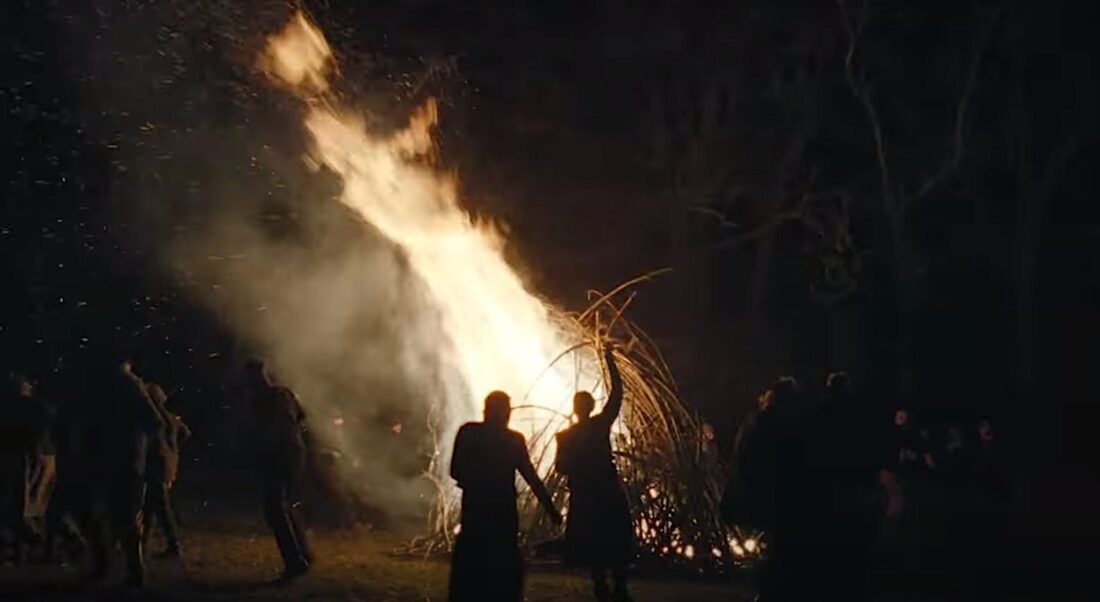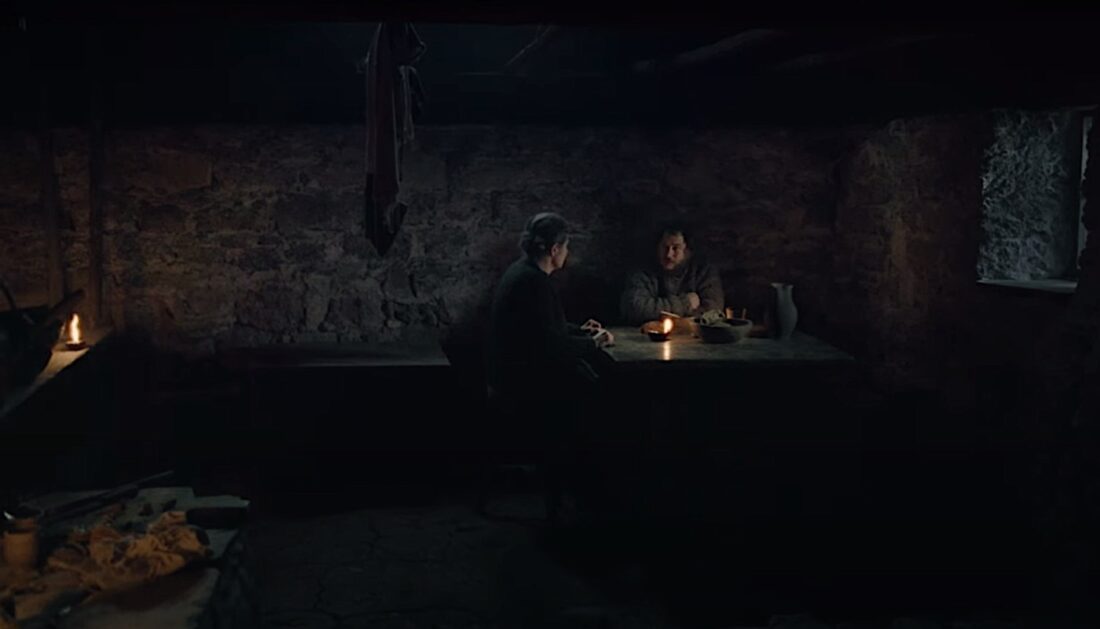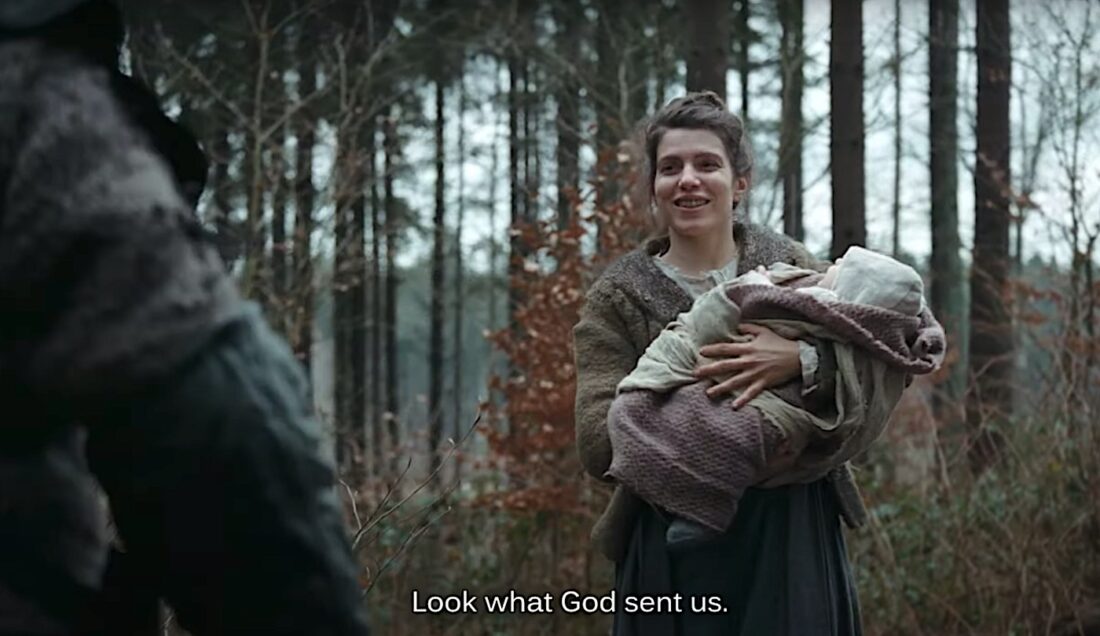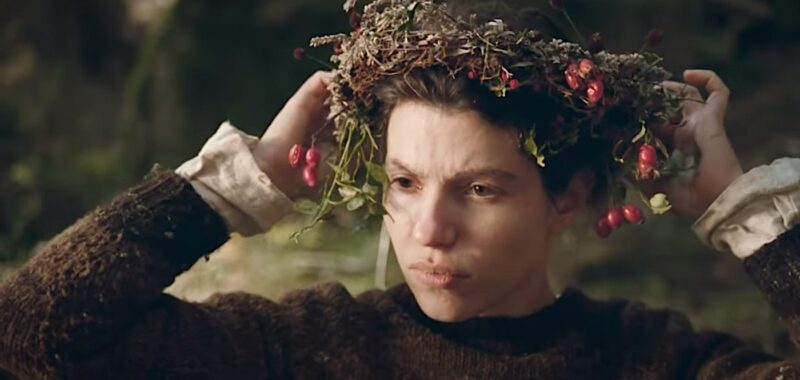This isn’t a spoiler but a warning: if you are particularly horrified by seeing the deaths of children or animals, stay far away from The Devil’s Bath, because it is built around those two things. The animal deaths are simply the texture of life in 1780s Austria; the children’s deaths are the movie’s fulcrum. The deaths are not gratuitous at all, but they are—especially in one case—drawn out, and awful to watch. The film was written and directed by Veronika Franz and Severin Fiala (Goodnight Mommy), and based on extensive historical research by Kathy Stewart.
In The Devil’s Bath, life is brutal. You work from the moment you wake, and your only respite is church, or the occasional dance around a bonfire—or, you know, the occasional dance around a corpse after a public execution. I’ve seen people refer to this movie as “folk horror”, but part of the point is that it isn’t horror, for the most part; it’s just life. And as with Handling the Undead, which I reviewed last week, I’ve found myself asking whether this film is “horror”, really, or rather a slow and deeply sad historical drama.

The plot is whisper thin: Agnes (Anja Plaschg) is a very religious young woman who lives in a small house with her mother and brother. At the opening of the film she’s marrying a man named Wolf (David Scheid), who seems kind and like he really cares for her—and that’s just it, he is kind. And he does really care for her. But they’re both doomed, because their society binds them into a structure that can’t allow for any autonomy, any dissent, any free thought or difference. As Agnes tries and fails to adjust to her new life, her mental health deteriorates, and she finally takes drastic measures to try to re-align herself with her society. That’s really all I can say plot-wise without spoiling things, because so much of The Devil’s Bath is about atmosphere that describing too much will rob you of the experience of the film.
But let me back up slightly. The film doesn’t open on Agnes’ marriage, it opens with a murder. The nature of the murder sets an extremely ominous tone. (Basically this movie is two hours of dread.) And the murder does tie in to the rest of the movie’s plot—the only possible problem is that it sets up an expectation of a type of folk horror that the film isn’t really interested in exploring.
Agnes and Wolf move into a house near his mother (Maria Hofstätter). There are the usual tensions between new bride and mother-in-law (though to be fair, Wolf’s mother does give Agnes a bucket of fish heads as a gift at one point—she’s trying) and the first part of the film is Agnes trying to fit in in her new community. Her mother and brother live a long hike through the woods away, and in this society the new wife is supposed to take her husband’s community as her own.
Agnes is completely cut off from her old life, and any friends she had. As the months pass, and she doesn’t become pregnant, she becomes increasingly mentally unstable. Her physical health craters. A visit to a barber doesn’t really help, going to church doesn’t help—it actually adds to her problems, because she’s far more observant than her new community, who think she’s overdoing it. A whole lot of things that will appear to us in 2024 as symptoms of depression are seen more as the possible influence of a dark spirit. And then things take an inevitable turn for the even darker and more violent.

We’re given a world where humans are tiny specks in nature. The world is lit by dim sun and guttering torches and that’s it. When Agnes works at her hearth, she holds a flaming stick in her mouth like a flashlight. The world is locked into gender roles—her purpose is to have children, her husband’s to father them. The twist here, if you want to call it that, is that Agnes desperately wants to be a mother, and it’s her husband who’s less keen on his role. But, of course, Agnes is the one who’s seen as the weak link in the society. The couple’s inability to communicate or redefine themselves is what drives the story along its tragic path, but there isn’t even the language to broach the gulf between them.
Anja Plaschg is unbelievably good as Agnes. This is an impossible role, and I never doubted her for a second. At the opening of the film, the role demands that she be an innocent child of nature. Often she has only trees or her own house for scene partners, or perhaps the rotting corpse of a murderess. As her health deteriorates she has to move through a near-catatonic depression, and into behavior that I can only call feral cat-adjacent. There is a long confession scene, basically Plaschg speaking into the camera. While the actual priest sits on the other side of a screen, facing forward rather than looking at her, we the audience are trapped staring into her face. It’s an extraordinary performance, calling to mind Falconetti’s work in Passion of Joan of Arc in the sheer pain and vulnerability.
It stretches the boundaries of horror. Last year, people were arguing online about whether “cozy horror” could be a thing—personally I think it’s encompassed in the concept of “spooky”—but I found myself mulling the conversation again after The Devil’s Bath.
Is The Devil’s Bath horror?

As I said, I asked the question about Handling the Undead last week, and honestly I think that while I would call The Devil’s Bath horror, I would say it’s less solidly genre than Undead. It’s a slow, sad, grueling drama, with things that read as horror to a modern eye, but would be recognized as “normal life” by a lot of our great-grandmothers. Hell, even some of our grandmothers. The life the tradwives and cottagecore folk think they want. What of our current life will be cast as horror in the future, if some form of movies are still made 250 years from now?
As the film churns towards its ending, it promises a type of folk horror that never really materializes. Where The VVitch and Hereditary play with the gap between modern sensibilities and those of a past age, The Devil’s Bath does not give us the comforting illusion of the gap. We’re with Agnes in this world. We’re under her sacred canopy, with no other sky to look to. If a person is out of joint with society enough to be executed, that execution happens where the community can see it. This is right and proper. The body is displayed as its rots, because it’s necessary to see what happens to people who have created a rift in society. Especially the children, of course, how else will they learn? Suicides do not get a real burial, and their souls go to Hell, which is a real place, and leaving their corpses exposed acts as a reminder to others not to commit such a crime against God. If you want to hide a suicide, or show them mercy, then you, too, are committing a crime against God. God and Mary are watching everything you do. If you want to go to Heaven, which is a place as real as your mother-in-law’s cottage, you must be a good wife and mother and community member, and if you fail at all of that, even if it isn’t your fault, you have to find a way, any way, to make things right with your world, or else you will suffer when you die.
The folkways and household rituals tangle into the official religion—in this case German Catholicism—until they are one terrifying stew of sacrificial blood, dead bugs, guilt, pleas for forgiveness, and lilting songs to Mary.
If this movie has a monster, it might actually be Mary?
The ultimate woman in the culture, a pure virgin but also the greatest mother who ever lived. All our protagonist wants to do is to live up to that icon, in her behavior before marriage and in her life as a wife and mother after it. And when she fails, through no fault of her own, there is no place for her in society. In her failure, she is alienated from her own mind and self and has to take drastic action to use loopholes in her world to redeem herself.
So again, if you have the right kind of mindset, The Devil’s Bath is absolutely horror, no ghosts or demons required.
The Devil’s Bath is now playing on Shudder.

